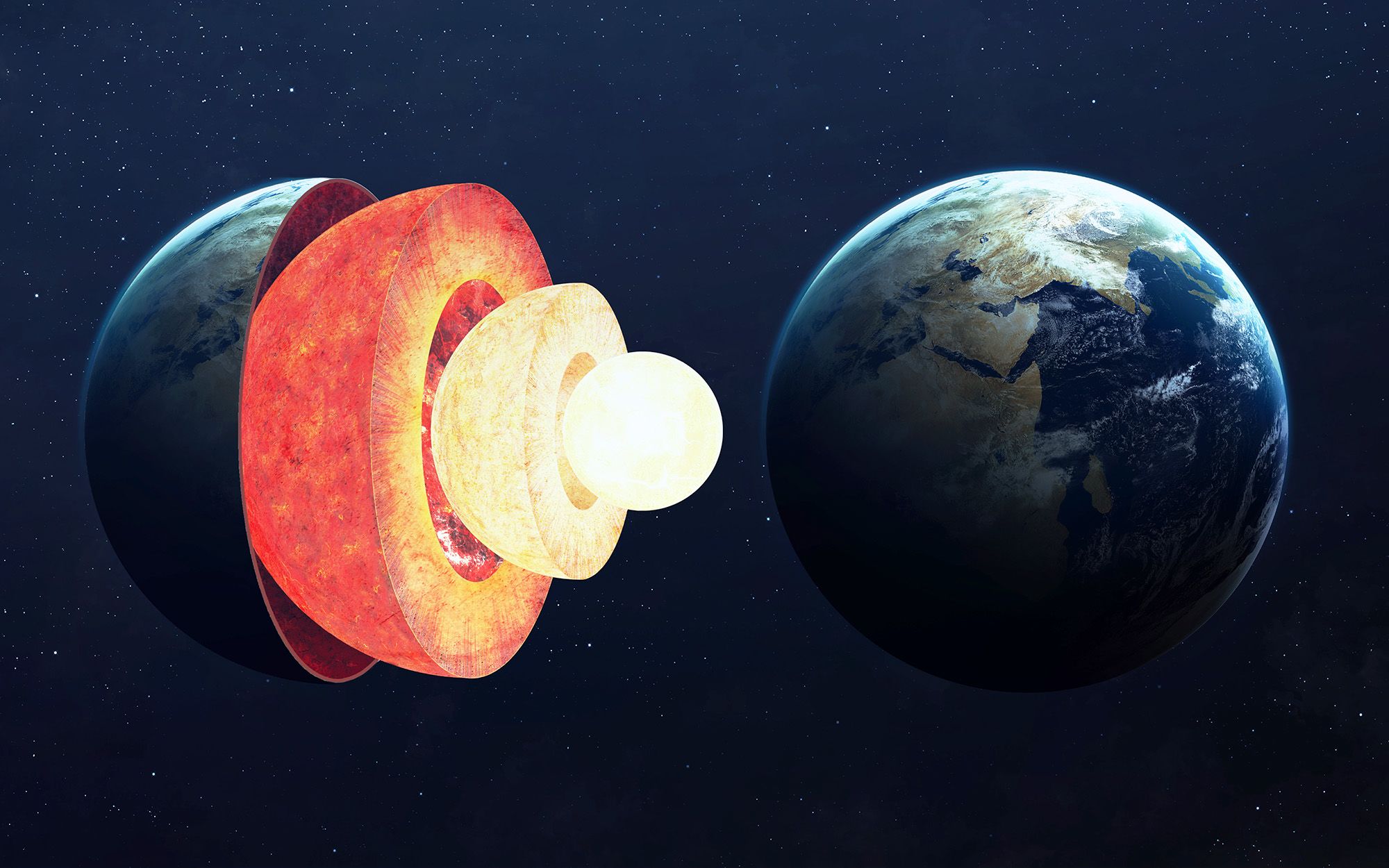
The Earth's inner core is a fascinating realm that holds numerous secrets and plays a crucial role in shaping our planet. Delving into the inner core unveils a realm of intense pressure, extreme temperatures, and captivating scientific phenomena. In this article, we will embark on an illuminating journey to uncover 25 great facts about the inner core, shedding light on its composition, formation, and significance. From its solid iron-nickel structure to its influence on Earth's magnetic field, each fact offers a glimpse into the captivating mysteries of this enigmatic region. Join us as we unravel the inner core's hidden wonders and gain a deeper understanding of the forces that shape our planet from within.
Key Takeaways:
- The Earth’s inner core, made of solid iron and nickel, is as hot as the sun’s surface but remains solid due to immense pressure. It’s about 70% the size of the Moon and influences the planet’s magnetic field.
- The inner core, formed 1-1.5 billion years ago, rotates slightly faster than the rest of the Earth. Its properties offer valuable insights into the planet’s early history and the forces shaping its structure.
The Inner Core is a Solid Sphere
The inner core is the innermost part of the Earth, primarily composed of solid iron and nickel. This dense sphere, with a radius of about 1,220 kilometers, is believed to be as hot as the surface of the sun. The immense pressure at the Earth's core keeps the inner core solid despite the high temperatures.
The Inner Core is Approximately 70% the Size of the Moon
The inner core is roughly 70% of the Moon's size and is surrounded by the outer core, mantle, and crust. Its immense mass and high density play a crucial role in the Earth's magnetic field generation.
The Inner Core is a Recent Addition to Earth's Structure
The inner core is a relatively recent addition to the Earth's structure, having formed around 1-1.5 billion years ago. This transformation from a liquid to a solid core significantly influenced the Earth's geological and magnetic processes.
The Inner Core Rotates Slightly Faster than the Rest of the Planet
Although the inner core is solid, it rotates slightly faster than the rest of the planet. This gradual rotation is due to complex interactions between the solid inner core and the surrounding molten outer core.
The Inner Core's Temperature Exceeds 5,000 Degrees Celsius
The temperature at the inner core surpasses 5,000 degrees Celsius, making it hotter than the surface of the sun. This extreme heat is sustained by the immense pressure generated by the Earth's layers.
The Inner Core's Formation is Linked to Earth's Cooling Process
The formation of the inner core is intricately linked to the Earth's cooling process. As the planet gradually cooled over billions of years, the outer core solidified, leading to the creation of the inner core.
The Inner Core's Solid Composition is Attributed to Immense Pressure
The solid composition of the inner core is attributed to the tremendous pressure exerted by the layers above it. This pressure prevents the iron and nickel from melting, despite the intense heat.
The Inner Core's Discovery Revolutionized Geophysical Studies
The discovery of the inner core revolutionized geophysical studies, providing crucial insights into the Earth's composition and the mechanisms driving its magnetic field.
The Inner Core's Density is Greater than Gold or Lead
The inner core's density is greater than that of gold or lead, highlighting its remarkable mass and compactness. This high density plays a pivotal role in the Earth's gravitational pull.
The Inner Core's Growth Influences Earth's Magnetic Field
The growth of the inner core influences the Earth's magnetic field, contributing to the planet's magnetosphere and its ability to deflect solar winds and cosmic particles.
The Inner Core's Solidification Altered Earth's Dynamic Processes
The solidification of the inner core significantly altered Earth's dynamic processes, impacting its geological evolution and magnetic field dynamics.
The Inner Core's Composition Reflects Earth's Early Formation
The composition of the inner core offers valuable insights into the Earth's early formation and the processes that shaped the planet billions of years ago.
The Inner Core's Properties are Studied Using Seismic Waves
Scientists study the properties of the inner core using seismic waves generated by earthquakes. These waves provide essential data on the inner core's composition and structure.
The Inner Core's Boundary with the Outer Core is Dynamic
The boundary between the inner core and the outer core is dynamic, influencing the Earth's magnetic field and geodynamic activities.
The Inner Core's Solid State is Maintained by Pressure
The solid state of the inner core is maintained by the immense pressure generated by the overlying layers, preventing the iron and nickel from transitioning into a liquid state.
The Inner Core's Growth Impacts Earth's Rotation
The growth of the inner core impacts the Earth's rotation, contributing to subtle changes in the planet's rotational dynamics over geological timescales.
The Inner Core's Formation is Linked to Earth's Magnetic Field Generation
The formation of the inner core is intricately linked to the generation of the Earth's magnetic field, a vital component for sustaining life on the planet.
The Inner Core's Study Enhances Understanding of Earth's Interior
Research on the inner core enhances our understanding of the Earth's interior, shedding light on its composition, dynamics, and evolutionary processes.
The Inner Core's Solidification Altered Earth's Magnetic Field
The solidification of the inner core altered the Earth's magnetic field, influencing various geophysical phenomena and the planet's long-term stability.
The Inner Core's Properties Provide Clues to Earth's Early History
The properties of the inner core offer valuable clues to Earth's early history, offering glimpses into the planet's formative stages and the forces that shaped its structure.
The Inner Core's Dynamics Influence Geomagnetic Reversals
The dynamics of the inner core play a role in geomagnetic reversals, where the Earth's magnetic field periodically flips, impacting navigation and animal migration patterns.
The Inner Core's Composition Affects Earth's Magnetic Pole
The composition of the inner core influences the Earth's magnetic pole, shaping the planet's magnetic orientation and its interactions with solar radiation.
The Inner Core's Solid State is Sustained by Gravitational Forces
The solid state of the inner core is sustained by gravitational forces, preventing the iron and nickel from succumbing to the extreme heat at the Earth's core.
The Inner Core's Properties Unveil Earth's Inner Mysteries
The properties of the inner core unveil the Earth's inner mysteries, offering tantalizing glimpses into the planet's hidden depths and the forces that govern its dynamics.
The Inner Core's Growth Reflects Earth's Evolutionary Journey
The growth of the inner core reflects Earth's evolutionary journey, showcasing the planet's transformative processes and its enduring capacity for change.
The inner core, a solid sphere primarily composed of iron and nickel, is situated at the Earth's center, beneath the outer core, mantle, and crust. Despite its scorching temperatures exceeding 5,000 degrees Celsius, the inner core remains solid due to the immense pressure exerted by the layers above. This dense sphere, approximately 70% the size of the Moon, rotates slightly faster than the rest of the planet, contributing to the Earth's magnetic field generation. The inner core's formation around 1-1.5 billion years ago marked a significant milestone in the Earth's geological history, influencing its magnetic field dynamics and geophysical processes. Through seismic studies and geophysical research, scientists continue to unravel the inner core's mysteries, gaining valuable insights into the Earth's early formation and the forces that have shaped our planet over billions of years.
Conclusion
The inner core of the Earth is a fascinating and crucial component of our planet. It plays a vital role in generating the Earth's magnetic field, which shields us from harmful solar radiation. Through seismic studies and scientific research, we have gained valuable insights into the composition and behavior of the inner core. Its solid iron-nickel composition and extremely high temperatures present unique challenges for exploration and understanding. As we continue to delve deeper into the mysteries of the inner core, we uncover new knowledge that not only enhances our understanding of Earth's inner workings but also provides valuable insights into planetary formation and evolution.
FAQs
What is the inner core made of?
The inner core is primarily composed of solid iron and nickel, with some lighter elements such as oxygen, sulfur, and silicon.
How do scientists study the inner core?
Scientists study the inner core using seismic waves generated by earthquakes and nuclear explosions. By analyzing how these waves travel through the Earth, researchers can infer valuable information about the inner core's composition and properties.
Earth's inner core holds countless mysteries, yet its exploration is just one facet of our planet's wonders. For those seeking outdoor adventures, quality gear enhances experiences in nature. Campers find comfort and relaxation using camping hammocks, perfect for stargazing or reading amidst trees. Athletes and fitness enthusiasts recover faster from workouts with foam rollers, which help soothe sore muscles. Discovering Earth's secrets or preparing for your next excursion, knowledge and proper equipment make all the difference.
Was this page helpful?
Our commitment to delivering trustworthy and engaging content is at the heart of what we do. Each fact on our site is contributed by real users like you, bringing a wealth of diverse insights and information. To ensure the highest standards of accuracy and reliability, our dedicated editors meticulously review each submission. This process guarantees that the facts we share are not only fascinating but also credible. Trust in our commitment to quality and authenticity as you explore and learn with us.


